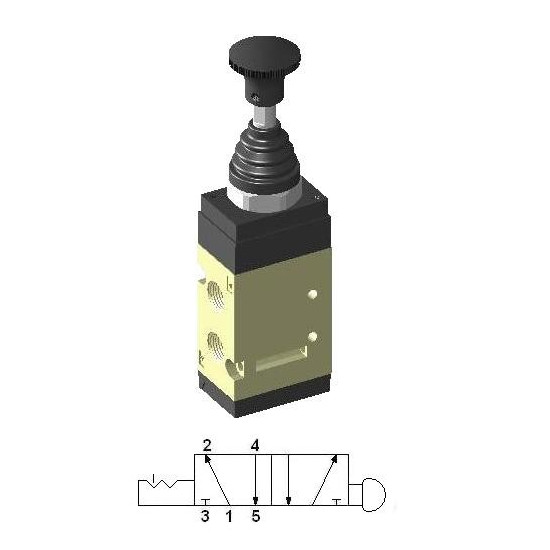Pneumatic Mushroom Valves: Selection Guide & Applications
Table of Contents
Pneumatic Mushroom Valves: Complete Selection Guide for Industrial Applications
In industrial automation systems, pneumatic mushroom valves represent an essential manual control solution for safe and efficient management of compressed air flow. These components, characterized by their robust design and intuitive operation via a mushroom-type pushbutton, are fundamental in applications requiring emergency stops, circuit lockout, or direct manual control in USA industrial environments.
What is a Pneumatic Mushroom Valve?
A pneumatic mushroom valve is a manually actuated directional control device operated via a large, ergonomic pushbutton head, typically red for emergency functions. This valve type allows operators to interrupt or restore compressed air flow in a pneumatic circuit quickly and safely, being especially valued in applications where direct human intervention is critical for operational safety.
The "mushroom" design of the actuator facilitates activation even in emergency situations when operators need to react rapidly. These valves are typically found in 3/2-way or 5/2-way configurations, enabling various control strategies depending on system requirements.
Operating Principle
The operation of a pneumatic mushroom valve is based on mechanical displacement of an internal spool or disc through pressure exerted on the mushroom pushbutton. When the actuator is pressed, the position of internal passages changes, altering the direction of compressed air flow between inlet, outlet, and exhaust ports.
Two primary operating modes exist:
- Momentary actuation: The valve returns to its original position when the pushbutton is released, via internal spring.
- Latching actuation: The pushbutton remains in the activated position until manually rotated for release, providing secure mechanical lockout of the circuit.
This latter characteristic is especially important in safety applications where the system must remain locked until conditions for resumption are verified.
Advantages and Industrial Applications
Mechanical valves with mushroom actuation offer significant advantages in USA industrial environments:
- Operational safety: Ergonomic and highly visible design facilitates activation in emergency situations.
- Mechanical reliability: Operating independently of electrical power, they function even during control system failures.
- Maintenance simplicity: Robust construction with few moving parts reduces maintenance requirements.
- Regulatory compliance: Designed according to industrial safety standards applicable in the United States, including OSHA requirements.
Typical applications include:
- Emergency stops on automated production lines
- Lockout of pneumatic cylinders during maintenance
- Manual control of presses and clamping systems
- Circuit deactivation in packaging machinery
- Safety systems in food processing and automotive manufacturing industries
Types of Mushroom Valves
Pneumatic mushroom valves are classified according to several technical criteria:
By Port Configuration
- 3/2-way: Suitable for simple control of single-acting actuators, with three ports and two positions.
- 5/2-way: Designed for double-acting cylinders, offering complete bidirectional control.
By Return Type
- Spring return: Automatic return to initial position when pushbutton is released.
- Latching: Remains in activated position until manual release via rotation.
By Size and Flow Capacity
Available in various nominal sizes, from 1/8" NPT to 1/2" NPT connections, selected according to required flow rate and system working pressure.
Selection Criteria
Proper selection of a pneumatic mushroom valve requires considering several technical parameters:
Working Pressure
Verify that the valve supports the system's maximum pressure, typically between 0 and 145 psi for standard industrial applications. Some applications may require high-pressure valves up to 232 psi.
Flow Capacity
Calculate required flow rate based on the air volume the valve must control, generally expressed in SCFM (standard cubic feet per minute). Insufficient flow will cause performance losses in connected actuators.
Connection Type
Select between threaded connections (NPT, BSP) or push-to-connect fittings, depending on system configuration and pneumatic tubing used.
Environmental Conditions
Consider operating temperature, exposure to humidity, dust, or chemical agents. For harsh environments, specify resistant materials or versions with IP65/IP67 protection ratings.
Safety Function
For emergency stop applications, select models with mechanical latching that comply with applicable machinery safety standards in the United States, including ANSI and OSHA regulations.
Installation and Maintenance
Installation Best Practices
- Install the valve in an accessible position clearly visible to operators
- Use FRL units to ensure clean and properly conditioned air
- Apply appropriate thread sealant on threaded connections, avoiding internal contamination
- Verify flow direction indicated on the valve body
- Ensure firm mechanical mounting using brackets or supports
Preventive Maintenance
Although mushroom valves require minimal maintenance, the following is recommended:
- Periodic visual inspection of pushbutton and housing condition
- Monthly functional verification of latching mechanism
- External cleaning with dry compressed air
- Replacement of internal seals according to manufacturer specifications
- Leak verification using precision pressure gauges
Common Troubleshooting
- Pushbutton does not return: Check internal spring or dirt accumulation in mechanism
- Air leaks: Inspect seals and gaskets, consider replacing internal cartridge
- Hard actuation: Lubricate mechanism with compatible pneumatic oil or reduce excessive pressure
Frequently Asked Questions About Pneumatic Mushroom Valves
At Pneumatig, we offer a complete selection of high-quality pneumatic valves, including mushroom valves designed for demanding industrial applications in the United States. Our technical team is available to advise you in selecting the most suitable component for your automation system, ensuring performance, safety, and regulatory compliance.


Login and Registration Form